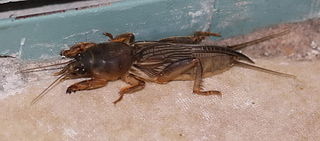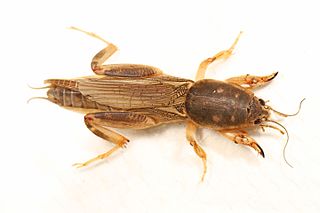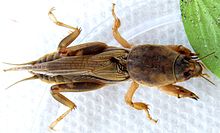
The family Gryllidae contains the subfamilies and genera which entomologists now term true crickets. Having long, whip-like antennae, they belong to the Orthopteran suborder Ensifera, which has been greatly reduced in the last 100 years : taxa such as the spider-crickets and allies, sword-tail crickets, wood or ground crickets and scaly crickets have been elevated to family level. The type genus is Gryllus and the first use of the family name "Gryllidae" was by Francis Walker.

Mole crickets are members of the insect family Gryllotalpidae, in the order Orthoptera. Mole crickets are cylindrical-bodied, fossorial insects about 3–5 cm (1.2–2.0 in) long as adults, with small eyes and shovel-like fore limbs highly developed for burrowing. They are present in many parts of the world and where they have arrived in new regions, may become agricultural pests.

The Caelifera are a suborder of orthopteran insects. They include the grasshoppers and grasshopper-like insects, as well as other superfamilies classified with them: the ground-hoppers (Tetrigoidea) and pygmy mole crickets (Tridactyloidea). The latter should not be confused with the mole crickets (Gryllotalpidae), which belong to the other Orthopteran sub-order Ensifera.

Diaprepes abbreviatus, also known as the diaprepes root weevil, citrus root weevil and sugarcane rootstock borer weevil, is a species of weevil that is native to the Caribbean, where in Spanish it is colloquially called chichí. It has become an invasive pest in several locations in the United States.

Larra, also known as mole cricket wasps or mole cricket hunters, is a genus of wasps that prey on various species of mole crickets. They have gained prominence as integrated pest management agents.

Larra bicolor is a parasitoid wasp native to South America. It was introduced into Florida as a biological pest control of invasive mole crickets.
Sam W. Heads is a British palaeontologist, a Fellow of the Linnean Society of London, a Fellow of the Royal Entomological Society, as well as a former Officer and Editor-in-Chief at the Orthopterists' Society.

Gryllotalpa orientalis is a species of mole cricket in the family Gryllotalpidae, commonly known as the oriental mole cricket. It is found in much of Asia and Australasia. At one time, this species was misidentified as G. africana and thought to have a widespread distribution in both Africa and Asia, but in the 1980s, G. orientalis was recognised as a separate species. It is a polyphagous pest, damaging crops by gnawing their roots.
Pheropsophus aequinoctialis is a species of ground beetle from Central and South America that feeds as larvae on the eggs of mole crickets but as an adult is a generalist feeder.

Gryllus rubens, commonly known as the southeastern field cricket, is one of many cricket species known as a field cricket. It occurs throughout most of the Southeastern United States. Its northern range spans from southern Delaware to the extreme southeastern corner of Kansas, with a southern range stretching from Florida to eastern Texas.
Steinernema scapterisci, the mole cricket nematode, is a species of nematode in the order Rhabditida. It is a parasite of insects in the order Orthoptera, the grasshoppers, crickets and their allies. Native to southern South America, it was introduced into Florida in the United States in an effort to provide a biological control of pest (Neoscapteriscus) mole crickets.
Ormia depleta, sometimes called the Brazilian red-eyed fly, is a species of fly in the family Tachinidae. It is a parasitoid of mole crickets in the genus Scapteriscus. It is native to South America but has been imported into the United States and elsewhere as a biological pest control agent.

Neoscapteriscus vicinus, commonly known as the tawny mole cricket, is a species of insect in the mole cricket family, Gryllotalpidae. This species is native to South America and also occurs in the Southern United States, where it arrived as a contaminant of ship's ballast around 1900. Colombian insect taxonomist Oscar Cadena-Castañeda studied specimens of the genus which had been called Scapteriscus, and decided that it included two groups; a smaller group and a larger group that he named Neoscapteriscus in 2015. North American mole cricket taxonomists agreed with his decision and altered Orthoptera Species File Online accordingly.

Scapteriscus borellii, the southern mole cricket, is a species of insect in the family Gryllotalpidae. It is native to South America but is also present in the southern United States where it was introduced around 1900.
Scapteriscus abbreviatus, the short-winged mole cricket, is a species of insect in the mole cricket family, Gryllotalpidae. It is native to South America but has been introduced inadvertently into Florida, in the United States. Unlike other related species, it is unable to fly, nor do the males emit songs in order to attract females.

The New Zealand mole cricket is a wingless member of the mole cricket family Gryllotalpidae. Endemic to New Zealand, it lives underground and is rarely seen. It is now restricted to parts of the southern North Island.

Gryllidea is an infraorder that includes crickets and similar insects in the order Orthoptera. There are two superfamilies, and more than 6,000 described species in Gryllidea.
Neoscapteriscus borellii, the southern mole cricket, is a species of mole cricket in the family Gryllotalpidae.

Neoscapteriscus is a genus of two-clawed mole crickets in the family Gryllotalpidae. At least 23 described species are placed in Neoscapteriscus.

The Gryllotalpoidea are a superfamily of insects that includes the mole crickets and the ant crickets. The type genus is Gryllotalpa.












